- About Us
- Columns
- Letters
- Cartoons
- The Udder Limits
- Archives
- Ezy Reading Archive
- 2024 Cud Archives
- 2023 Cud Archives
- 2022 Cud Archives
- 2021 Cud Archives
- 2020 Cud Archives
- 2015-2019
- 2010-2014
- 2004-2009
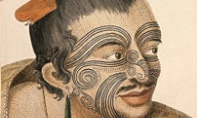 |
From The Margins To The Mainstream — Attitudes toward tattooing and piercing from the late 50's to the present day |
" … Scars of self-harm, tattooing and body piercing are often associated with diagnosis of personality disorders or substance misuse."
British Psychiatric Journal 1998, Kelwyn Williams, Specialist Registrar in Community Psychiatry. Wotton Lawn Hospital, Horion Road, Gloucester.
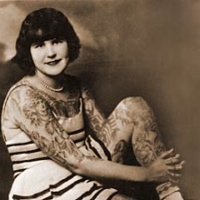 You can't judge a book by its cover. Or can you? The practice of cosmetic alteration of the body, as ancient a human practice though it may be, has gone through peaks and troughs of popularity in the modern world. A trend of the wealthy and highborn can turn to the mark of a criminal quicker than you'd think.
You can't judge a book by its cover. Or can you? The practice of cosmetic alteration of the body, as ancient a human practice though it may be, has gone through peaks and troughs of popularity in the modern world. A trend of the wealthy and highborn can turn to the mark of a criminal quicker than you'd think.
The practice of tattooing was re-introduced to Europe (tattooing had been done there for millennia before but the art had been lost) by British sailors sent to explore the South Pacific islands for the Crown. The images scratched onto the flesh of the natives there inspired the seamen to get marked themselves, sparking something of a tattoo craze in the West. By the mid to late 1800's, ink was linked to adventure, exploration and bravery. Lady Randolph Churchill was marked with a snake around her wrist and King Frederick the 9th of Denmark was quite heavily tattooed even by today?s standards. The practice spread to the States where it first took root again with sailors. The advent of the electric tattooing gun led to tattoo shops being opened all over the Eastern and Western seaboards of America. Automation and proliferation brought the cost of tattoos down considerably, which worked both for and against the art. While it was easier for those interested in the medium to find a tattoo artist, the stigma of tattooing being a practice of the seedy was starting to take hold. 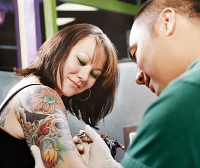 In circuses and freak shows all over the nation heavily inked people were being put on display for paying customers. Those voyeurs who had been sufficiently impressed could then spend 3 dollars and take home a tattoo of their own courtesy of the circus? resident scratch artist.
In circuses and freak shows all over the nation heavily inked people were being put on display for paying customers. Those voyeurs who had been sufficiently impressed could then spend 3 dollars and take home a tattoo of their own courtesy of the circus? resident scratch artist.
After the Second World War the reputation of the tattooist and the tattooed went down considerably. Legal efforts on behalf of politicians had relegated tattooing strictly to designated, often seamy areas of port cities due to fears (sometimes justifiably held) of the spread of disease. To be tattooed now had a decided stink of marginality in an era of conformity. The art would stay a pass time of sailors, criminals and prostitutes for two decades almost exclusively.
Piercing as a human practice is likely as old as tattooing, though it never enjoyed as much social acceptance. For thousands of years native peoples all over the world pierced various areas of their bodies for purposes of adornment and rites of passage. In Europe, it was a practice again mainly of sailors, rings put through the ears to signify a passing of the equator or to sharpen eyesight for high-seas watches. For women piercing of the ears for jewelry had been practiced for centuries.
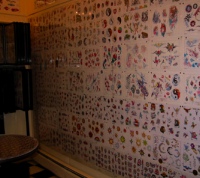 It was not until the 1960?s when the ideas of Fakir Mustafar, born Roland Loomis, began to ignite interest in ?extreme piercing? again, first in the U.S. and then worldwide. Fascinated by the Muslim and Hindu holy men (called "Fakirs" from which he took his name) who would pierce their bodies with hooks and sharpened steel to no ill effect, Fakir began to formulate the notion of the ?New Primitive?. It was Fakir Mustafar?s argument that life in the West had become intolerably sheltered and that our protection from pain, from trial, was robbing us from valuable self-knowledge. Adopting the trial piercing of various tribes from all over the world Mustafar planted the seed for interest in body modifications the effects of which are still being felt in the movement today.
It was not until the 1960?s when the ideas of Fakir Mustafar, born Roland Loomis, began to ignite interest in ?extreme piercing? again, first in the U.S. and then worldwide. Fascinated by the Muslim and Hindu holy men (called "Fakirs" from which he took his name) who would pierce their bodies with hooks and sharpened steel to no ill effect, Fakir began to formulate the notion of the ?New Primitive?. It was Fakir Mustafar?s argument that life in the West had become intolerably sheltered and that our protection from pain, from trial, was robbing us from valuable self-knowledge. Adopting the trial piercing of various tribes from all over the world Mustafar planted the seed for interest in body modifications the effects of which are still being felt in the movement today.
" … For example, the desire to be tattooed, pierced, to dress in shocking clothing, at its basis it has obviously unpleasant emotions … ?
Psychology of Mode, part of article entitled Psychology, dreams, reflexes. Vladimir Ivanov, 2003.
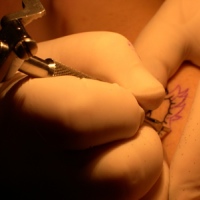 The 1960?s represented a paradigm shift time for many things, no less tattooing and piercing. The civil rights movement, anti-war protests and women?s liberation movement all collaborated in closing the door on post World War Two style conservative values. On the West Coast of America, the flower children found a fascination and unlikely partnership briefly with the outlaw motorcycle clubs that had formed and grew there after the 1940?s. The rebel imagery of the bikers was adopted by the avant-garde of the youth movement, actors like Peter Fonda and singers like Janis Joplin who in turn opened the doors for middle class kids everywhere to get their own marks. The resurgence of interest brought much needed new blood to the art, people from the field of fine arts put down their texts and picked up tattoo guns, women all over the world for the first time began to view a career as a tattoo artist as viable, a development which lead to styles of design more flattering to women instead of clumsy sailor flash. The spirit of rebellion so pervasive of the time breathed new life into rebel arts.
The 1960?s represented a paradigm shift time for many things, no less tattooing and piercing. The civil rights movement, anti-war protests and women?s liberation movement all collaborated in closing the door on post World War Two style conservative values. On the West Coast of America, the flower children found a fascination and unlikely partnership briefly with the outlaw motorcycle clubs that had formed and grew there after the 1940?s. The rebel imagery of the bikers was adopted by the avant-garde of the youth movement, actors like Peter Fonda and singers like Janis Joplin who in turn opened the doors for middle class kids everywhere to get their own marks. The resurgence of interest brought much needed new blood to the art, people from the field of fine arts put down their texts and picked up tattoo guns, women all over the world for the first time began to view a career as a tattoo artist as viable, a development which lead to styles of design more flattering to women instead of clumsy sailor flash. The spirit of rebellion so pervasive of the time breathed new life into rebel arts.
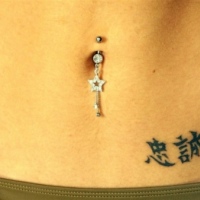 As 1960?s idealism gave way to 1970?s crass selfishness, the tone of tattooing and piercing turned darker but by no means suffered a setback. Instead of flowers and eagles, rebellious youth now returned to tattooing?s rowdy past for inspiration; skulls, knives and dice. The punk rock movement took Fakir Mustafars rejection of bourgeois conformity to the next level, piercing eyebrows, lips and noses not with native bones but with cold stainless steel safety pins. The art of the margins was again being used, at once as a flag of rejection and so the rejected might feel safe in each others company. The 1970?s made the tattoo and piercing culture we see today more than possible but inevitable.
As 1960?s idealism gave way to 1970?s crass selfishness, the tone of tattooing and piercing turned darker but by no means suffered a setback. Instead of flowers and eagles, rebellious youth now returned to tattooing?s rowdy past for inspiration; skulls, knives and dice. The punk rock movement took Fakir Mustafars rejection of bourgeois conformity to the next level, piercing eyebrows, lips and noses not with native bones but with cold stainless steel safety pins. The art of the margins was again being used, at once as a flag of rejection and so the rejected might feel safe in each others company. The 1970?s made the tattoo and piercing culture we see today more than possible but inevitable.
Today, when tattooing and piercing are at their height, the question still must be asked: Why? Pornography and sites like the Suicide Girls have taken the inherently sensual art of tattooing and made it intensely sexy. Hollywood movie stars, by necessity of profession, people who stick to the norms of society, walk Rodeo Drive with pierced nipples and expensive ink. In the psychological field tattooing and piercing are both still firmly believed to be the products of ?inner turmoil and distress?; a sort of external sign of inner damnation. With so many people either inked or pierced, are we a society 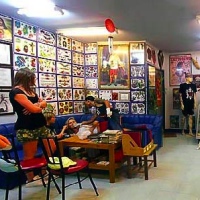 then of the emotionally wounded? Or is this just another wave of fashion that will soon pass, once again leaving tattooing and piercing to the people on the margins of society to whom it had always belonged.
then of the emotionally wounded? Or is this just another wave of fashion that will soon pass, once again leaving tattooing and piercing to the people on the margins of society to whom it had always belonged.
References
Caplan, Jane. Written On The Body: The Tattoo In European & American History, Jane Caplan.
Rubin, Arnold. Marks Of Civilization: Artistic Transformations Of The Human Body.
Padraig Mara works various jobs. He lives and writes in Bayonne, NJ, USA.
